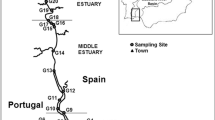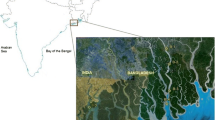Abstract
This study investigated the sources of organic matter and sediment depositional environment within fluviatile sediments of the Ganges–Meghna (GM) delta plains. The very low contents of trace metals e.g., chromium (Cr), cobalt (Co), scandium (Sc), and vanadium (V), organic carbon content, and cerium (Ce)-anomaly data of sediments indicate the redox conditions that fall within the boundary of oxic–anoxic condition, with dominantly oxic conditions in the sediment deposition environment. The higher atomic carbon nitrogen (C/N)a ratios and depleted stable carbon isotope ratio (δ13C) values for sediments from three study areas indicated the terrestrial sources of organic matter derived from C3 plant materials, whereas the contribution of organic materials from C4 vegetation and riverine productivity is low. Some silty sand samples exhibited lower (C/N)a ratios and enriched δ13C values in Sonargaon and Faridpur areas that are attributed to the adsorption of ammonium ions on clay minerals and the contribution of organic matter from C4 plants. Total sulfur over total organic carbon (TS/TOC) ratios in sediments of the Ganges delta reflect the nonmarine environments of sediment deposition. The lower ratios of syringyl to vanillyl phenols (S/V), cinnamyl to vanillyl phenols (C/V), and acid to aldehyde in vanillyl phenols (Ad/Al)v observed in Daudkandi indicate that the lignin in sediments derived from dominant woody gymnosperm sources and is very highly degraded. By contrast, the S/V ratio, C/V ratios, and [Ad/Al]v ratios in Faridpur suggest that the lignin in sediments derived from a mixture of woody and nonwoody angiosperm plant tissue contribution that underwent high degradation as well.







Similar content being viewed by others
References
Alberdi-Genolet M, Tocco R (1999) Trace metals and organic geochemistry of the Machiques Member (Aptian–Albian) and La Luna Formation (Cenomanian–Campanian), Venezuela. Chem Geol 160:19–38
Anawar HM, Akai J, Komaki K, Terao H, Yoshioka T, Ishizuka T, Safiullah S, Kato K (2003) Geochemical occurrence of arsenic in groundwater of Bangladesh: sources and mobilization processes. J Geochem Explor 77:109–131
Banakar VK, Parthiban G, Pattan JN, Jauhari P (1998) Chemistry of surface sediment along a north-south transect across the equator in the Central Indian Basin: an assessment of biogenic and detrital influences on elemental burial on the seafloor. Chem Geol 147:217–232
Bernasconi SM, Barbieri A, Simona M (1997) Carbon and nitrogen isotope variations in sedimenting organic matter in Lake Lugano. Limnol Oceanogr 42:1755–1765
Boldrin A, Langone L, Miserocchi S, Turchetto M, Acri F (2005) Po River plume on the Adriatic continental shelf: dispersion and sedimentation of dissolved and suspended matter during different river discharge rates. Mar Geol 222–223:135–158
Dunn RJK, Welsh DT, Teasdale PR, Lee SY, Lemckert CJ, Meziane T (2008) Investigating the distribution and sources of organic matter in surface sediment of Coombabah Lake (Australia) using elemental, isotopic and fatty acid biomarkers. Continental Shelf Res 28:2535–2549
Ertel JR, Hedges JI (1984) The lignin component of humic substances: distribution among soil and sedimentary humic, fulvic, and base-insoluble fractions. Geochim Cosmochim Acta 48:2065–2074
Fernandes L, Nayak GN (2009) Distribution of sediment parameters and depositional environment of mudflats of Mandovi estuary, Goa, India. J Coastal Res 25:273–284
Fry B, Scalan RS, Parker PL (1977) Stable carbon isotopic evidence for two sources of organic matter in coastal sediments: seagrasses and plankton. Geochim Cosmochim Acta 41:1875–1877
Goni MA, Hedges JI (1992) Lignin dimers: structures, distributions and potential geochemical application. Geochim Cosmochim Acta 56:4025–4043
Goni MA, Nelson B, Blanchette RA, Hedges JI (1993) Fungal degradation of wood lignins: geochemical perspectives from CuO-derived phenolic dimers and monomers. Geochim Cosmochim Acta 57:3985–4000
Goni MA, Ruttenberger KC, Eglinton TI (1997) Sources and contribution of terrigenous organic carbon to surface sediments in the Gulf of Mexico. Nature 389:275–278
Goni MA, Monacci N, Gisewhite R, Ogston A, Crockett J, Nittrouer C (2006) Distribution and sources of particulate organic matter in the water column and sediments of the Fly River Delta, Gulf of Papua (Papua New Guinea). Estuar Coast Shelf Sci 69:225–245
Guggenberger G, Christensen GT, Zech W (1994) Land-use effects on the composition of organic matter in particle-size separates of soil: I. Lignin and carbohydrate signature. Eur J Soil Sci 45:449–458
Hedges JI (1992) Global biogeochemical cycles: progress and problems. Mar Chem 39:67–93
Hedges JI, Ertel JR (1982) Characterization of lignin by gas capillary chromatography of cupric oxide oxidation products. Anal Chem 54:174–178
Hedges JI, Keil RG (1995) Sedimentary organic matter preservation: an assessment and speculative synthesis. Mar Chem 49:81–115
Hedges JI, Clark WA, Quay PD, Richey JE, Devol AH, UdM Santos (1986) Compositions and fluxes of particulate organic material in the Amazon River. Limnol Oceanogr 31:717–738
Hedges JI, Clark WA, Cowie GL (1988) Fluxes and reactivities of organic matter in a coastal marine bay. Limnol Oceanogr 33:1137–1152
Jarrar G, Amireh B, Zachmann D (2000) The major, trace and rare earth element geochemistry of glauconites from the early Cretaceous Kurnub Group of Jordan. Geochem J 34:207–222
Kern RA, Schlesinger WH (1992) Carbon stores in vegetation. Nature 357:447–448
Koyama M, Matsushita R (1980) Use of neutron spectrum sensitive monitors for instrumental neutron activation analysis. Bull Ins Chem Res, Kyoto Univ 58:235–243
Kuzyk ZZA, Goñi MA, Stern GA, Macdonald RW (2008) Sources, pathways and sinks of particulate organic matter in Hudson Bay: evidence from lignin distributions. Mar Chem 112:215–229
Lobbes JM, Fitznar HP, Kattner G (2000) Biogeochemical characteristics of dissolved and particulate organic matter in Russian rivers entering the Arctic Ocean. Geochim Cosmochim Acta 64:2973–2983
Louchouarn P (1996) La dégradation de la lignine dans les sols indondés des réservoirs hydroélectriques du moyen-nord québécois. Congrès de l’Acfas, Montréal
McArthur JM, Tyson RV, Thomson J, Mattey D (1992) Early diagenesis of marine organic matter: alteration of the carbon isotope composition. Mar Geol 105:51–61
Medina E, Francisco M, Sternberg L, Anderson WT (2005) Isotopic signatures of organic matter in sediments of the continental shelf facing the Orinoco Delta: possible contribution of organic carbon from savannas. Estuar Coast Shelf Sci 63:527–536
Meyers PA (1997) Organic geochemical proxies of paleoceanographic, paleolimnologic, and paleoclimatic processes. Org Geochem 27:213–250
Muller PJ (1977) C/N ratio in Pacific deep-sea sediments: effect of inorganic ammonium and organic nitrogen compound sorbed by clays. Geochim Cosmochim Acta 41:765–776
Musashino M (1990) The Panthalassa-a cerium-rich Atlantic-type ocean: sedimentary environments of the Tamba Group, Southwest Japan. Tectonophysics 181:165–177
Onstad GD, Canfield DE, Quay PD, Hedges JI (2000) Sources of particulate organic matter in rivers from the continental USA: lignin phenol and stable carbon isotope compositions. Geochim Cosmochim Acta 64:3539–3546
Opsahl S, Benner R (1995) Early diagenesis of vascular plant tissues: lignin and cutin decomposition and biogeochemical implications. Geochim Cosmochim Acta 59:4889–4904
Petsch ST, Berner RA, Eglinton TI (2000) A field study of the chemical weathering of ancient sedimentary organic matter. Org Geochem 31:475–487
Ramesh R, Al Ramamanthan, Ramesh S, Purvaja R, Subramanian V (2000) Distribution of rare earth elements and heavy metals in the surficial sediments of the Himalayan river system. Geochem J 34:295–319
Redfield AC, Ketchum BA, Richards FA (1963) The influence of organisms on the composition of sea-water. In: Hill MN (ed) The sea, vol 2. Wiley, London, pp 26–77
Sampei Y, Matsumoto E (2001) C/N ratios in a sediment core from Nakaumi Lagoon, southwest Japan-usefulness as an organic source indicator. Geochem J 35:189–205
Swarzenski PW, Campbell PL, Osterman LE, Poore RZ (2008) A 1000-year sediment record of recurring hypoxia off the Mississippi River: the potential role of terrestrially derived organic matter inputs. Mar Chem 109:130–142
Tareq SM (2006) Advanced application of lignin biomarker and isotope signatures in lacustrine deposits to the reconstruction of paleovegetation. D.Sc. dissertation, Nagoya University, Japan, p 258
Tareq SM, Tanaka N, Ohta K (2004) Biomarker signature in tropical wetland: lignin phenol vegetation index (LPVI) and its implications for reconstructing the paleoenvironment. Sci Total Environ 324:91–103
Taylor SR, McLennan SM (1985) The continental crust: its composition and evolution. Blackwell, Oxford, p 311
Wedepohl K (ed) (1969) Handbook of geochemistry. Springer, Berlin
Wright J, Schrader H, Holser W (1987) Paleoredox variations in ancient oceans recorded by rare earth elements in fossil apatite. Geochim Cosmochim Acta 51:631–644
Acknowledgments
We acknowledge the assistance of Dr. Toshio Ishizuka, Ocean Research Institute, University of Tokyo, in sample collection. The authors are grateful to Prof. Kikuo Kato and Kaori Komaki, Nagoya University, for cooperation in the elemental analysis of sediment samples. The anonymous reviewers are thanked for their comments to improve the manuscript.
Author information
Authors and Affiliations
Corresponding author
Rights and permissions
About this article
Cite this article
Anawar, H.M., Yoshioka, T., Konohira, E. et al. Sources of organic carbon and depositional environment in the Bengal delta plain sediments during the Holocene period. Limnology 11, 133–142 (2010). https://doi.org/10.1007/s10201-009-0301-9
Received:
Accepted:
Published:
Issue Date:
DOI: https://doi.org/10.1007/s10201-009-0301-9




